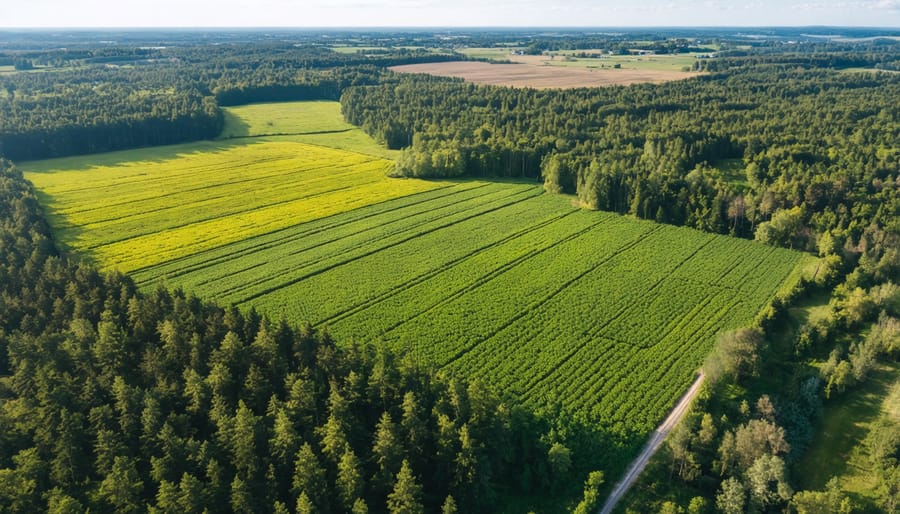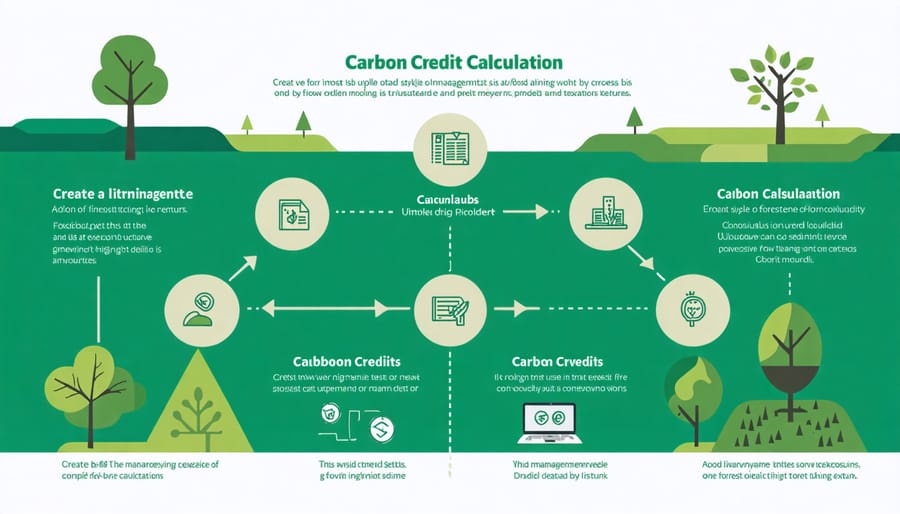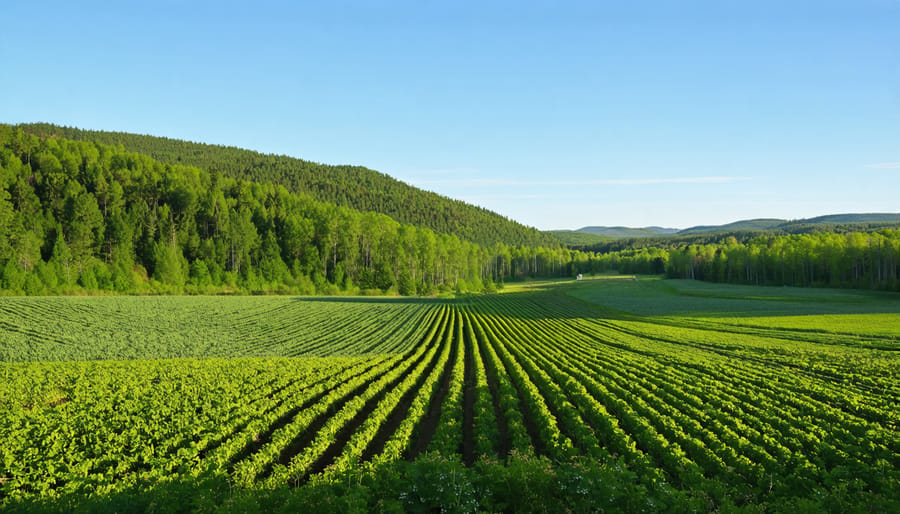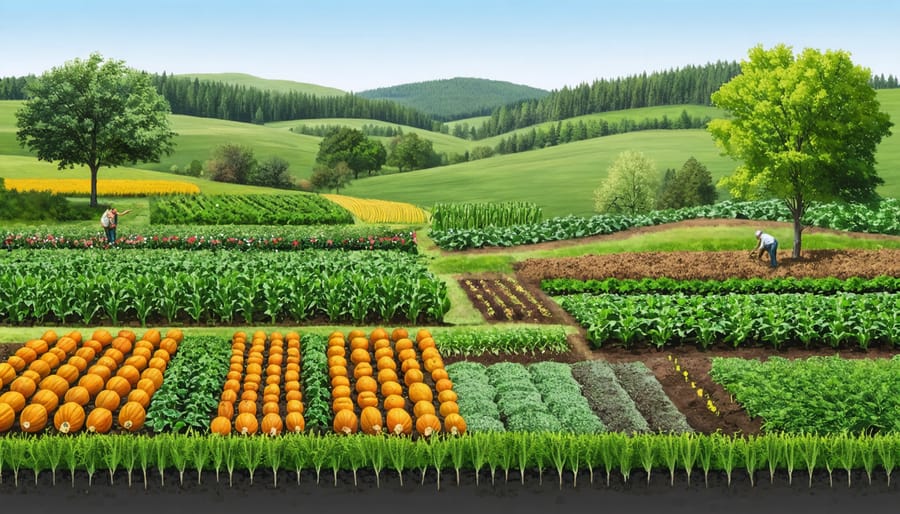Forests deliver vital ecosystem services worth over $4.7 trillion annually to Canadian agriculture, fundamentally shaping our ability to produce food sustainably in Alberta and beyond. From the aspen parklands that naturally filter groundwater for irrigation to the shelterbelts that protect Prairie cropland, these living systems work tirelessly to support agricultural production. Every hectare of forest captures up to 6 tonnes of carbon annually while providing habitat for pollinators that service nearby crops, regulating local weather patterns, and preventing soil erosion that could otherwise cost farmers thousands in lost productivity. For Alberta producers, understanding and maximizing these natural benefits has become increasingly critical as climate pressures mount. When properly integrated into agricultural operations, forest ecosystem services reduce input costs, enhance crop resilience, and create new revenue streams through carbon credits and biodiversity offsets. This practical approach to working with nature, rather than against it, represents one of the most powerful tools available to modern Canadian farmers seeking to build operations that are both profitable and environmentally sustainable.

The Natural Benefits Your Farm’s Forest Provides
Water Management and Soil Health
Forests play a crucial role in maintaining the delicate balance of water cycles and soil health across Alberta’s agricultural landscape. Through their extensive root systems and canopy cover, forests provide remarkable water management benefits that help regulate water flow and prevent soil erosion.
During heavy rainfall, forest canopies intercept precipitation, allowing water to gradually reach the ground rather than causing immediate runoff. This natural process helps prevent flooding and ensures steady water infiltration into the soil. In spring, when snowmelt can be a concern for many Alberta farmers, forested areas help regulate water release, reducing the risk of soil saturation and erosion.
The rich organic matter from fallen leaves and decomposing plant material improves soil structure and water-holding capacity. Local studies show that fields adjacent to woodlots typically maintain better moisture levels during dry periods, thanks to reduced wind speed and improved soil composition. This natural moisture regulation can reduce irrigation needs by up to 25% in some cases.
Forest soils also act as natural filters, removing pollutants and excess nutrients from water as it moves through the ground. This filtering process helps maintain water quality in nearby streams and aquifers, benefiting both agricultural operations and local ecosystems. Many Alberta farmers have noticed improved crop resilience and reduced soil amendment needs in areas where forest buffers have been maintained or established.
Natural Pest Control and Pollination
Forests play a vital role in supporting agricultural production through their diverse communities of beneficial insects, birds, and other wildlife. These natural ecosystems provide natural pest control solutions that can significantly reduce the need for chemical pesticides on nearby farmland.
Here in Alberta, native birds like chickadees and warblers help control pest populations by feeding on harmful insects. A single chickadee family can consume up to 9,000 caterpillars during their nesting season. Similarly, bats emerging from forest edges can eat thousands of moths and other night-flying crop pests.
The pollination services provided by forest-dwelling insects are equally valuable. Wild bee species, which nest in dead trees and forest soil, contribute an estimated $4.5 billion to Canadian agriculture annually through crop pollination. Studies from central Alberta show that farms within 1 km of natural forest patches experience up to 40% better pollination rates in canola fields.
Maintaining forest patches near cropland also provides habitat for beneficial predatory insects like ground beetles and parasitic wasps. These insects naturally control agricultural pests like aphids and cutworms. Local farmers who preserve wooded areas on their land report spending significantly less on pest control while maintaining healthy crop yields.
By protecting and enhancing forest ecosystems around farmland, producers can harness these valuable services while contributing to biodiversity conservation.
Turning Forest Services into Farm Income
Carbon Credit Opportunities
Alberta farmers are increasingly discovering opportunities to participate in carbon markets through strategic forest management on their properties. By enhancing their land’s carbon capture potential, farmers can generate additional income while contributing to climate change mitigation.
The Alberta Carbon Offset System allows farmers to earn carbon credits for maintaining and expanding forested areas on their land. These credits can be sold to industries required to offset their emissions, creating a new revenue stream for agricultural operations. Typical activities that qualify include establishing shelterbelts, maintaining woodlots, and implementing sustainable forest management practices.
To participate, farmers need to register their projects with approved carbon offset programs and follow specific protocols for measuring and verifying carbon sequestration. The process typically involves:
– Conducting baseline assessments of existing forest cover
– Implementing approved forest management practices
– Regular monitoring and reporting of carbon stocks
– Third-party verification of results
Many Alberta farmers have successfully entered this market, with some earning between $20-30 per acre annually through carbon credits. Local agricultural extension offices and forest management consultants can help farmers navigate the registration process and maximize their earning potential through proper forest management strategies.
Remember that carbon credit programs require long-term commitments, usually 20-25 years, ensuring both environmental benefits and sustained income opportunities for participating farms.

Sustainable Wood Products
In Alberta’s woodlands, sustainable wood harvesting presents a valuable opportunity for landowners to generate additional income while maintaining healthy forest ecosystems. Through selective harvesting practices, farmers can remove mature trees strategically, allowing younger trees to thrive and maintaining crucial wildlife habitat.
Local success stories, like the Peterson family farm near Whitecourt, demonstrate how careful timber management can provide steady revenue streams. The Petersons harvest approximately 2-3% of their woodlot annually, focusing on mature spruce and pine while leaving seed trees and maintaining diverse age structures throughout their forest.
Value-added opportunities exist beyond raw lumber sales. Many Alberta farmers have found success in specialty markets, such as providing hardwoods for furniture makers, selling cedar posts for fencing, or marketing decorative burls to craftspeople. These niche markets often command premium prices compared to standard timber sales.
When planning harvests, consider working with a professional forester to develop a sustainable management plan. They can help identify optimal harvest cycles, ensure compliance with provincial regulations, and connect you with reputable buyers. The Alberta Woodlot Extension Program offers resources and workshops to help landowners maximize the value of their forest products while maintaining ecological integrity.
Remember that sustainable wood harvesting isn’t just about immediate returns – it’s an investment in your land’s future productivity and resilience. By maintaining forest cover and managing harvests responsibly, you’re protecting soil health, water quality, and wildlife habitat while creating a renewable source of income.
Government Incentives and Programs
Canadian farmers looking to maintain and enhance forest ecosystem services can access various government support programs at both federal and provincial levels. In Alberta, the Environmental Farm Plan (EFP) provides funding for implementing sustainable practices, including forest management initiatives. Farmers can receive up to 70% cost-sharing for eligible projects such as riparian area protection and shelterbelts establishment.
The Agricultural Clean Technology Program offers financial assistance for implementing environmentally sustainable practices, including forest conservation projects. This federal initiative provides funding of up to $2 million for larger-scale projects that demonstrate clear environmental benefits.
The Alberta Conservation Association (ACA) runs several grant programs supporting landowners in maintaining wildlife habitat and forest ecosystems. Their Conservation, Community, and Education Grants provide funding for projects that enhance biodiversity and protect natural areas.
The Canadian Agricultural Partnership (CAP) framework includes specific provisions for environmental stewardship, offering support for farmers implementing forest management practices. Through CAP, Alberta producers can access technical expertise and financial assistance for developing forest management plans.
Local conservation authorities frequently partner with municipalities to offer additional incentives, including property tax reductions for maintaining forested areas and technical support for sustainable forest management practices. These programs often include educational components and networking opportunities with other farmers implementing similar practices.
To access these programs, farmers are encouraged to contact their local agricultural fieldman or visit their regional Alberta Agriculture office for guidance on application processes and eligibility requirements.
Real Success Stories: Alberta Farmers Leading the Way

The Miller Family’s Forest Buffer Success
The Miller family’s 400-hectare farm near Red Deer, Alberta, stands as a testament to the transformative power of strategic forest buffer management. When Sarah and James Miller inherited their family farm in 2015, they faced declining crop yields and increasing soil erosion issues. Their solution? Implementing a carefully planned forest buffer system along their field boundaries and waterways.
Working with local forestry experts, the Millers planted a mix of native species including white spruce, trembling aspen, and chokecherry in 15-metre-wide strips. These buffer zones were strategically positioned to protect their wheat and canola fields from prevailing winds while supporting natural pollinators and beneficial insects.
Within three years, the results were remarkable. The Millers documented a 23% increase in crop yields in fields adjacent to the forest buffers, particularly during drought conditions. Soil testing revealed improved moisture retention and reduced erosion, with topsoil loss decreasing by approximately 65%.
“The forest buffers have done more than just protect our crops,” says Sarah Miller. “We’ve noticed a significant increase in beneficial insects and birds that help control pests naturally. Our irrigation costs have also decreased because the trees help retain soil moisture.”
The Millers’ success has inspired neighbouring farms to implement similar practices. They now host regular farm tours and workshops, sharing their experience with other Alberta farmers interested in forest buffer implementation. Their project demonstrates how thoughtful forest management can enhance farm productivity while supporting local ecosystem services.
The family estimates their initial investment will be fully recovered within eight years through improved yields and reduced input costs, proving that environmental stewardship and profitable farming can go hand in hand.
Mountain View Farm’s Biodiversity Boost
Located just outside of Red Deer, Alberta, Mountain View Farm has transformed from a traditional grain operation into a thriving example of forest ecosystem integration. Owner Sarah Thompson discovered that by preserving and expanding the natural forest patches on her 640-acre property, she could create multiple revenue streams while enhancing soil health and crop yields.
In 2018, Thompson began by mapping existing woodlots and identifying potential areas for expansion. Working with local conservation authorities, she developed a management plan that included establishing windbreaks, creating wildlife corridors, and maintaining mature forest stands. The results have been remarkable.
“Our honey production has increased by 40% since we started maintaining diverse forest edges,” Thompson explains. “The variety of flowering trees and shrubs provides extended nectar sources throughout the season.” The farm now generates $15,000 annually from honey sales alone.
The forested areas also provide sustainable firewood harvesting, generating an additional $8,000 yearly. Perhaps most significantly, Thompson has documented a 25% reduction in wind damage to crops in fields protected by strategic windbreaks, translating to approximately $20,000 in saved crops annually.
Wildlife viewing opportunities have created another income stream, with local photography groups paying to access the property during peak migration seasons. “We’ve identified over 45 bird species in our forest patches,” Thompson notes. “This diversity has opened up unexpected agritourism opportunities.”
The farm’s success has inspired neighboring properties to explore similar initiatives, creating a growing network of interconnected forest ecosystems across central Alberta. Thompson regularly hosts workshops for other farmers interested in replicating her model, emphasizing that forest integration can enhance rather than compete with traditional farming practices.
As we’ve explored throughout this article, forest ecosystem services offer tremendous potential for Canadian farmers looking to enhance their agricultural operations. By integrating trees and forested areas into farming systems, producers can access multiple benefits, from improved soil health and water management to enhanced biodiversity and additional income streams.
The success stories we’ve seen across Alberta demonstrate that implementing climate-resilient farming practices through agroforestry is not only possible but increasingly necessary for long-term farm sustainability. Whether you’re managing a small family farm or a larger agricultural operation, the key is to start small and scale up based on your specific needs and conditions.
To begin incorporating forest ecosystem services into your farm, consider these next steps:
1. Assess your land’s potential for tree integration and identify areas that could benefit most from forest services
2. Connect with local agricultural extension services and forestry experts for guidance
3. Start with a pilot project, such as establishing a windbreak or riparian buffer
4. Document your progress and monitor changes in soil health, water retention, and biodiversity
5. Join or form a local farmer network to share experiences and resources
Remember that implementing forest ecosystem services is a long-term investment in your farm’s future. While some benefits may take time to materialize, the foundation you lay today will contribute to a more resilient and productive agricultural system tomorrow.
Take advantage of available resources and support programs through provincial and federal agencies. Many offer technical assistance and potential funding for agroforestry initiatives. By working together and sharing knowledge, we can build a stronger, more sustainable agricultural sector that benefits from the vital services our forest ecosystems provide.
The journey toward integrated forest-agricultural systems may seem challenging, but you’re not alone in this endeavour. Your efforts contribute to a growing movement of Canadian farmers leading the way in sustainable agriculture.










